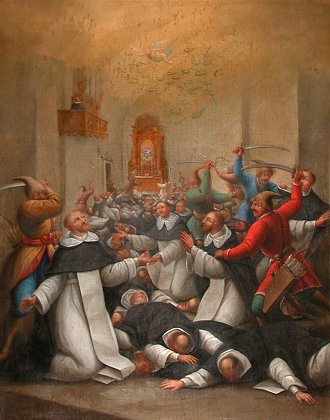Sacking Of Sandomierz (1260) on:
[Wikipedia]
[Google]
[Amazon]
The siege and second sack of
 In the 1950s and 1960s, Polish archaeologists found mass graves with human bones, located near the St. Jacob church. After extensive research, it was concluded that they were victims of the 1260 invasion. The bones are now kept in the cellar of the church.
In the 1950s and 1960s, Polish archaeologists found mass graves with human bones, located near the St. Jacob church. After extensive research, it was concluded that they were victims of the 1260 invasion. The bones are now kept in the cellar of the church.
Battles of the Mongol invasions of Poland, Sandomierz (1259-1260) 1260 in Europe 13th-century massacres Massacres in Poland 1260 in the Mongol Empire 1259 in the Mongol Empire Conflicts in 1259 Conflicts in 1260 1259 in Europe Looting {{Poland-battle-stub
Sandomierz
Sandomierz (pronounced: ; la, Sandomiria) is a historic town in south-eastern Poland with 23,863 inhabitants (as of 2017), situated on the Vistula River in the Sandomierz Basin. It has been part of Świętokrzyskie Voivodeship (Holy Cross Provi ...
took place in 1259-1260 during the second Mongol invasion of Poland. The city was razed and residents massacred.Stanisław Krakowski, ''Polska w walce z najazdami tatarskimi w XIII wieku'', MON, 1956, pp. 181-201
Sandomierz, the most important city of southeastern medieval Kingdom of Poland
The Kingdom of Poland ( pl, Królestwo Polskie; Latin: ''Regnum Poloniae'') was a state in Central Europe. It may refer to:
Historical political entities
* Kingdom of Poland, a kingdom existing from 1025 to 1031
* Kingdom of Poland, a kingdom exi ...
, and the second largest city of Lesser Poland
Lesser Poland, often known by its Polish name Małopolska ( la, Polonia Minor), is a historical region situated in southern and south-eastern Poland. Its capital and largest city is Kraków. Throughout centuries, Lesser Poland developed a ...
, was captured by the invaders on February 2, 1260. The Mongol and Ruthenian armies completely destroyed the city, murdering almost all residents, including 49 Dominican friars with their abbot Sadok, who hid in the St. Jacob church (see Sadok and 48 Dominican martyrs from Sandomierz). As a result, old Sandomierz, located on the Staromiejskie Hill, ceased to exist.
According to a legend, before the sack the Mongols sent a Ruthenian envoy to Sandomierz, promising Castellan
A castellan is the title used in Medieval Europe for an appointed official, a governor of a castle and its surrounding territory referred to as the castellany. The title of ''governor'' is retained in the English prison system, as a remnant o ...
Piotr Krepa that the city would be spared if its residents gave away their valuables. Krepa decided to negotiate with the invaders, and entered the Mongol camp, where he was murdered. The sack itself was described in the Galician–Volhynian Chronicle
The ''Galician–Volhynian Chronicle'' ( uk, Галицько-Волинський літопис), called "Halicz-Wolyn Chronicle" in Polish historiography, is a prominent benchmark of the Old Ruthenian literature and historiographyKotlyar, M. G ...
.
Aftermath
In 1286, High Duke of Poland Leszek II the Black decided to rebuild Sandomierz in a new location, more convenient for defence. The city once again received itsMagdeburg rights
Magdeburg rights (german: Magdeburger Recht; also called Magdeburg Law) were a set of town privileges first developed by Otto I, Holy Roman Emperor (936–973) and based on the Flemish Law, which regulated the degree of internal autonomy within ...
(the original document still exists), and its first '' wojt'' was a nobleman named Witkon. Duke Leszek also invited Dominican friars from other locations, giving them a plot of land within city limits.
 In the 1950s and 1960s, Polish archaeologists found mass graves with human bones, located near the St. Jacob church. After extensive research, it was concluded that they were victims of the 1260 invasion. The bones are now kept in the cellar of the church.
In the 1950s and 1960s, Polish archaeologists found mass graves with human bones, located near the St. Jacob church. After extensive research, it was concluded that they were victims of the 1260 invasion. The bones are now kept in the cellar of the church.
References
Online
Battles of the Mongol invasions of Poland, Sandomierz (1259-1260) 1260 in Europe 13th-century massacres Massacres in Poland 1260 in the Mongol Empire 1259 in the Mongol Empire Conflicts in 1259 Conflicts in 1260 1259 in Europe Looting {{Poland-battle-stub